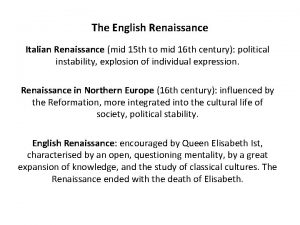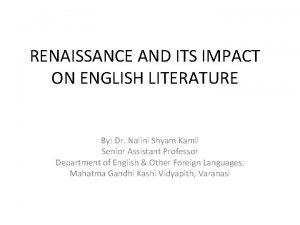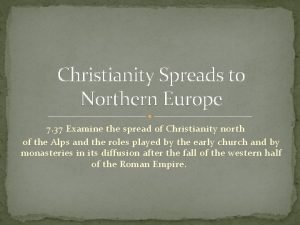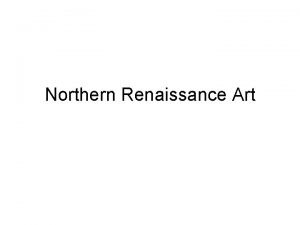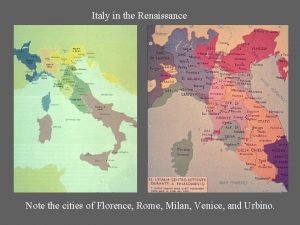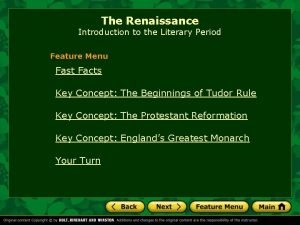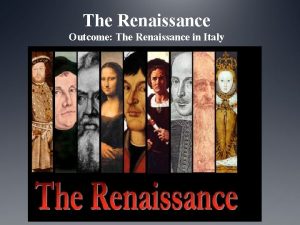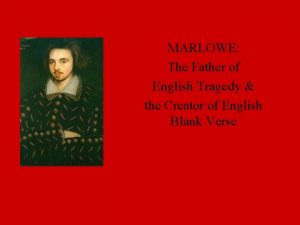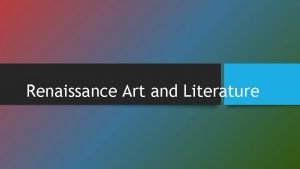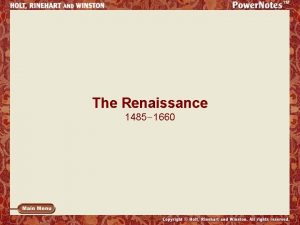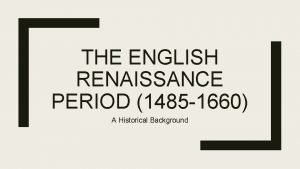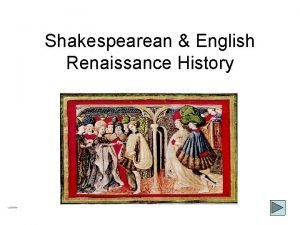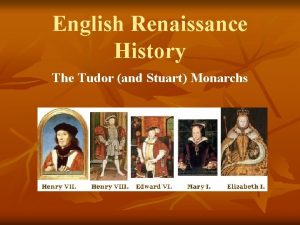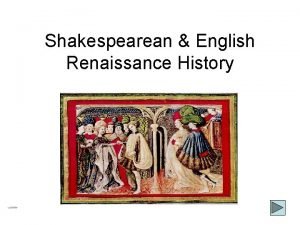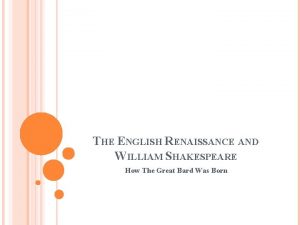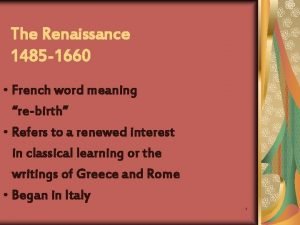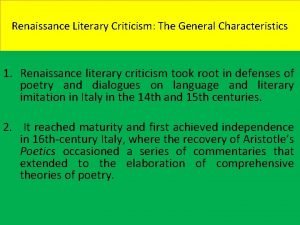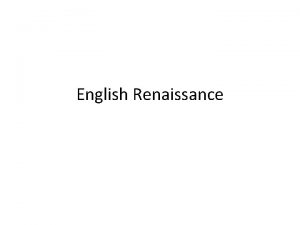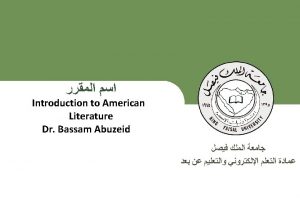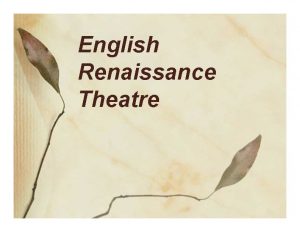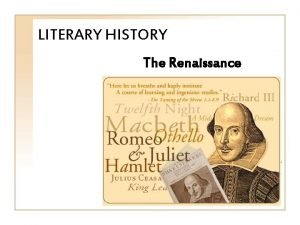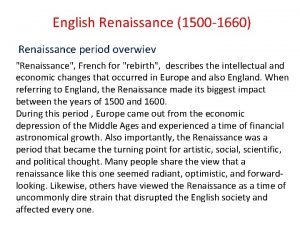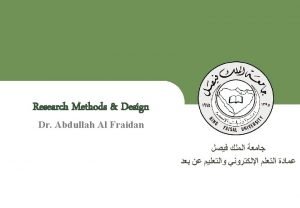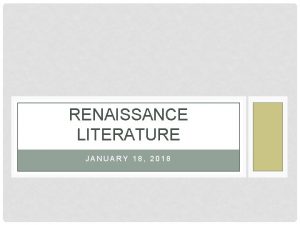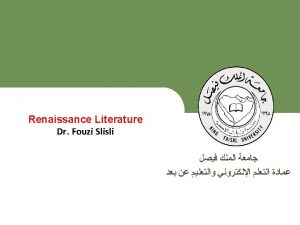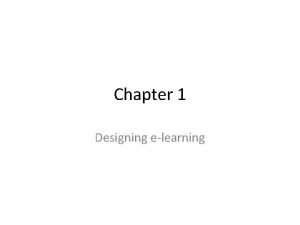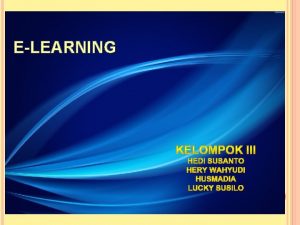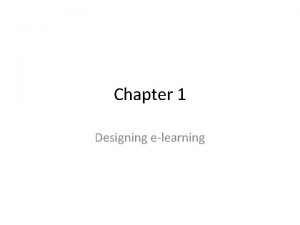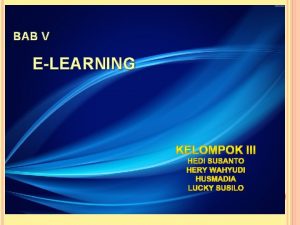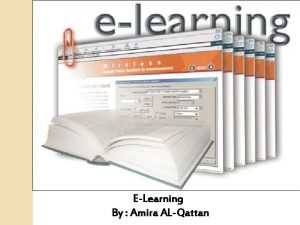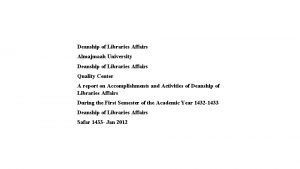English Literature Renaissance Literature Deanship of ELearning and




















- Slides: 20


English Literature Renaissance Literature ﻋﻤﺎﺩﺓ ﺍﻟﺘﻌﻠﻢ ﺍﻹﻟﻜﺘﺮﻭﻧﻲ ﻭﺍﻟﺘﻌﻠﻴﻢ ﻋﻦ ﺑﻌﺪ Deanship of E-Learning and Distance Education [ ] ﺟﺎﻣﻌﺔ ﺍﻟﻤﻠﻚ ﻓﻴﺼﻞ King Faisal University

The Elizabethan Era v. Politically, it was an unsettled time. Although Elizabeth reigned for some fortyfive years, there were constant threats, plots, and potential rebellions against her. v Protestant extremists (Puritans) were a constant presence; many left the country for religious reasons, in order to set up the first colonies in Virginia and Pennsylvania, and what became the American colonies. v. Catholic dissent (Counter Reformation) reached its most noted expression in Guy Fawkes’s Gunpowder Plot of 5 November 1605, still remembered on that date every year. And Elizabeth’s one-time favorite, the Earl of Essex, led a plot against her which considerably unsettled the political climate of the end of the century. ﻋﻤﺎﺩﺓ ﺍﻟﺘﻌﻠﻢ ﺍﻹﻟﻜﺘﺮﻭﻧﻲ ﻭﺍﻟﺘﻌﻠﻴﻢ ﻋﻦ ﺑﻌﺪ Deanship of E-Learning and Distance Education [ 3 ] ﺟﺎﻣﻌﺔ ﺍﻟﻤﻠﻚ ﻓﻴﺼﻞ King Faisal University

Elizabethan Era Cond v. Elizabeth’s reign did, however, give the nation some sense of stability, and a considerable sense of national and religious triumph when, in 1588, the Spanish Armada, the fleet of the Catholic King Philip of Spain, was defeated. v. England now had sovereignty over the seas, and her seamen (pirates or heroes, depending on one’s point of view) plundered the gold of the Spanish Empire to make their own Queen the richest and most powerful monarch in the world. ﻋﻤﺎﺩﺓ ﺍﻟﺘﻌﻠﻢ ﺍﻹﻟﻜﺘﺮﻭﻧﻲ ﻭﺍﻟﺘﻌﻠﻴﻢ ﻋﻦ ﺑﻌﺪ Deanship of E-Learning and Distance Education [ 4 ] ﺟﺎﻣﻌﺔ ﺍﻟﻤﻠﻚ ﻓﻴﺼﻞ King Faisal University

English Literature of the Renaissance v. The literature of the English Renaissance contains some of the greatest names in all world literature: Shakespeare, Marlowe, Webster, and Jonson, among the dramatists; Sidney, Spenser, Donne, and Milton among the poets; Bacon, Nashe, Raleigh, Browne, and Hooker in prose; and, at the center of them all, the Authorized Version of the Bible, published in 1611. ﻋﻤﺎﺩﺓ ﺍﻟﺘﻌﻠﻢ ﺍﻹﻟﻜﺘﺮﻭﻧﻲ ﻭﺍﻟﺘﻌﻠﻴﻢ ﻋﻦ ﺑﻌﺪ Deanship of E-Learning and Distance Education [ 5 ] ﺟﺎﻣﻌﺔ ﺍﻟﻤﻠﻚ ﻓﻴﺼﻞ King Faisal University

Important Questions v. So many great names and texts are involved because so many questions were under debate: what is man, what is life for, why is life so short, what is good and bad (and who is to judge), what is a king, what is love ? These are questions which have been the stuff of literature and of philosophy since the beginning of time, but they were never so actively and thoroughly made a part of everyday discussion as in the Elizabethan and Jacobean ages. ﻋﻤﺎﺩﺓ ﺍﻟﺘﻌﻠﻢ ﺍﻹﻟﻜﺘﺮﻭﻧﻲ ﻭﺍﻟﺘﻌﻠﻴﻢ ﻋﻦ ﺑﻌﺪ Deanship of E-Learning and Distance Education [ 6 ] ﺟﺎﻣﻌﺔ ﺍﻟﻤﻠﻚ ﻓﻴﺼﻞ King Faisal University

Humanist Education in the Renaissance v Humanist Scholars were great advocates of education. v. Humanists like Thomas More contributed to the founding of new grammar schools across England in the 16 th century. v. Education became available to children of farmers and average citizens as well as the children of gentry and nobility. v. England’s two universities, Oxford and Cambridge, flourished in the Renaissance. v. At the heart of the curriculum was the study of classical literature and Latin, the language of international scholarship and diplomacy. ﻋﻤﺎﺩﺓ ﺍﻟﺘﻌﻠﻢ ﺍﻹﻟﻜﺘﺮﻭﻧﻲ ﻭﺍﻟﺘﻌﻠﻴﻢ ﻋﻦ ﺑﻌﺪ Deanship of E-Learning and Distance Education [ 7 ] ﺟﺎﻣﻌﺔ ﺍﻟﻤﻠﻚ ﻓﻴﺼﻞ King Faisal University

The Most Commonly Studied Authors v. Cicero for style v. Aristotle and Horace for their theories on poetry v. Ovid for his use of mythology v. Virgil and Quintilian for their use of rhetorical figures v. Students were required to translate passages from classical authors and imitate their styles, genres and rhetorical figures. v. In many schools, students studied and performed classical drama, usually Seneca’s tragedies and the Roman comedies of Plautus and Terrence. v. The aim from these studies was primarily to improve students’ fluency in Latin and develop their skills in public speaking ﻋﻤﺎﺩﺓ ﺍﻟﺘﻌﻠﻢ ﺍﻹﻟﻜﺘﺮﻭﻧﻲ ﻭﺍﻟﺘﻌﻠﻴﻢ ﻋﻦ ﺑﻌﺪ Deanship of E-Learning and Distance Education [ 8 ] ﺟﺎﻣﻌﺔ ﺍﻟﻤﻠﻚ ﻓﻴﺼﻞ King Faisal University

The English Language v. The English that was spoken and written in the Renaissance is known as early modern English. It has similarities and differences with modern English. v. There was no standardized form of early modern English. v. The modern grammatical system was not established yet and dialect variations and irregularities were common. Words were also often spelt differently. Many words have now disappeared or changed meaning. v. English and other European languages were considered simple and rude and inferior to Latin. Calls for improving the vernacular were common. v. The mission to improve the English language was nationalistic, resulting from England’s isolation after the Reformation. ﻋﻤﺎﺩﺓ ﺍﻟﺘﻌﻠﻢ ﺍﻹﻟﻜﺘﺮﻭﻧﻲ ﻭﺍﻟﺘﻌﻠﻴﻢ ﻋﻦ ﺑﻌﺪ Deanship of E-Learning and Distance Education [ 9 ] ﺟﺎﻣﻌﺔ ﺍﻟﻤﻠﻚ ﻓﻴﺼﻞ King Faisal University

The English Language (cont) v. To improve the English language, authors encouraged the imitation of classical syntax and the borrowing of words from Latin and other European languages. Others, like Edmund Spencer, encouraged reviving archaic native words from English dialects. v. By the end of the 16 th century English had been transformed: massive expansion in its vocabulary. v. Without this linguistic revolution, English Renaissance literature would not have been as rich and diverse. ﻋﻤﺎﺩﺓ ﺍﻟﺘﻌﻠﻢ ﺍﻹﻟﻜﺘﺮﻭﻧﻲ ﻭﺍﻟﺘﻌﻠﻴﻢ ﻋﻦ ﺑﻌﺪ Deanship of E-Learning and Distance Education [ 10 ] ﺟﺎﻣﻌﺔ ﺍﻟﻤﻠﻚ ﻓﻴﺼﻞ King Faisal University

How the English Viewed the World? v. Global exploration and international trade led to the flourishing of travel literature. Renaissance Europeans became increasingly aware of that the world was inhabited by people who were different from them, but few Englishmen or women had a firsthand experience of that. Most read or heard about it only. v. There were few foreign immigrants in England but most lived in London, and the largest immigrant community were European Protestants. v. Ambassadors and traders from Africa and the East were occasional visitors, Jews were banished from living in England in 1290 and Elizabeth I banished blacks in 1601. ﻋﻤﺎﺩﺓ ﺍﻟﺘﻌﻠﻢ ﺍﻹﻟﻜﺘﺮﻭﻧﻲ ﻭﺍﻟﺘﻌﻠﻴﻢ ﻋﻦ ﺑﻌﺪ Deanship of E-Learning and Distance Education [ 11 ] ﺟﺎﻣﻌﺔ ﺍﻟﻤﻠﻚ ﻓﻴﺼﻞ King Faisal University

Otherness Abroad v. The only other way in which Europeans could meet people of different nations was through travel, but travel was expensive and difficult and needed government permission. v. Most English people (including many Renaissance authors) never left the country, and relied on second hand information for their knowledge on other countries and other cultures. v. As a result Renaissance writings on other peoples and cultures were based on stereotypes and vacillated between fascination, fear and repulsion. v. Often those who were seen as foreign or different were demonized, especially true for Jews and Muslims. ﻋﻤﺎﺩﺓ ﺍﻟﺘﻌﻠﻢ ﺍﻹﻟﻜﺘﺮﻭﻧﻲ ﻭﺍﻟﺘﻌﻠﻴﻢ ﻋﻦ ﺑﻌﺪ Deanship of E-Learning and Distance Education [ 12 ] ﺟﺎﻣﻌﺔ ﺍﻟﻤﻠﻚ ﻓﻴﺼﻞ King Faisal University

Otherness (cont) v. Similarly, Protestants demonized Catholics and vice versa. v. Europeans also associated blackness with sin and ugliness and whiteness with purity and beauty. Blacks were often presented in negative stereotypes as wicked, unattractive and prone to vice and lust. These stereotypes are vividly illustrated in Shakespeare’s villainous Moor, Aaron in Titus Andronicus, and less so in his other famous black protagonist Othello, though the latter is represented in a more complex and sympathetic fashion. v. Similar representation European representations of Native Americans. Some stigmatized them as primitive and barbaric, and others like Michel de Montaigne praised them as “noble” savages. ﻋﻤﺎﺩﺓ ﺍﻟﺘﻌﻠﻢ ﺍﻹﻟﻜﺘﺮﻭﻧﻲ ﻭﺍﻟﺘﻌﻠﻴﻢ ﻋﻦ ﺑﻌﺪ Deanship of E-Learning and Distance Education [ 13 ] ﺟﺎﻣﻌﺔ ﺍﻟﻤﻠﻚ ﻓﻴﺼﻞ King Faisal University

England Europe v. Catholic countries like France and Italy are represented in English literature in contradictory ways. v. Both countries were admired for their literature, but… v. The French are portrayed as fickle, vain and untrustworthy v. Italians are caricatured as deviant, corrupt, vengeful and lecherous. v. The Spaniards are often portrayed as hot-blooded religious extremists. v. By contrast, the representation of the Dutch and Germans (fellow Protestants) is generally benign, though comical: Dutch characters often have funny accents and Germans are often presented as hard drinkers. ﻋﻤﺎﺩﺓ ﺍﻟﺘﻌﻠﻢ ﺍﻹﻟﻜﺘﺮﻭﻧﻲ ﻭﺍﻟﺘﻌﻠﻴﻢ ﻋﻦ ﺑﻌﺪ Deanship of E-Learning and Distance Education [ 14 ] ﺟﺎﻣﻌﺔ ﺍﻟﻤﻠﻚ ﻓﻴﺼﻞ King Faisal University

Representation of Irish, Scotts and Welsh v. Wales had been part of the English realm since 1535 and caused little problems and the representation of Wales in English literature is largely positive. Sometimes they are mocked for their accents, but they are generally portrayed as loyal and good-natured. v. Because the Irish resisted English domination, their representation in English literature is negative. Irish tribal customs are stigmatized by English authors like Edmund Spencer as primitive and threatening. v. Scotts are also often represented as barbarous, primitive and dangerous. ﻋﻤﺎﺩﺓ ﺍﻟﺘﻌﻠﻢ ﺍﻹﻟﻜﺘﺮﻭﻧﻲ ﻭﺍﻟﺘﻌﻠﻴﻢ ﻋﻦ ﺑﻌﺪ Deanship of E-Learning and Distance Education [ 15 ] ﺟﺎﻣﻌﺔ ﺍﻟﻤﻠﻚ ﻓﻴﺼﻞ King Faisal University

Patronage v. Because generosity was a marker of status, kings and rich nobles often acted as patrons or sponsors of the arts, offering support to painters, sculptors, musicians, players and writers. v. Some patrons like Lady Mary Sidney even invited artists and writers to stay with them for prolonged periods of time. v. In return for patronage, writers dedicated their work to the patrons, sometimes in the form of a brief preface or a dedicatory letter, and other times by composing a dedicatory poem ﻋﻤﺎﺩﺓ ﺍﻟﺘﻌﻠﻢ ﺍﻹﻟﻜﺘﺮﻭﻧﻲ ﻭﺍﻟﺘﻌﻠﻴﻢ ﻋﻦ ﺑﻌﺪ Deanship of E-Learning and Distance Education [ 16 ] ﺟﺎﻣﻌﺔ ﺍﻟﻤﻠﻚ ﻓﻴﺼﻞ King Faisal University

Patronage v. Earning a living through publications for living writers was almost impossible. Aspiring writers courted patrons. v. Rancor and competition between authors were common. Fristration with this situation was not unusual. v. Writers complain about the difficulty securing patronage and express their dislike for a system that forced them to be flatterers. v. Ben Jonson, for example, struggled to reconcile the demands of patrons, the literary market and artistic integrity. He became one of the first English writers to make a careers from his own writing. Few of his peers managed to do that. v. There was no copyright laws and most of the period’s published authors were independently wealthy or wrote in their spare time only. ﻋﻤﺎﺩﺓ ﺍﻟﺘﻌﻠﻢ ﺍﻹﻟﻜﺘﺮﻭﻧﻲ ﻭﺍﻟﺘﻌﻠﻴﻢ ﻋﻦ ﺑﻌﺪ Deanship of E-Learning and Distance Education [ 17 ] ﺟﺎﻣﻌﺔ ﺍﻟﻤﻠﻚ ﻓﻴﺼﻞ King Faisal University

Publications and Book Trade v. There were two main forms of publications: manuscripts and print ü Manuscripts were handwritten texts. Prior to the invention of print, most literature circulated in manuscript form. ü The invention of the moveable-type printing revolutionized the circulation of texts. It became possible to produce multiple copies quickly and cheaply. v. The new form of printing was developed by Johannes Gutenberg in the midfifteen century and was pioneered in England by William Caxton when he set up a printing press in Westminster Abbey in 1476. v. Most of the new presses were set up in London, which became the center of the new book trade. ﻋﻤﺎﺩﺓ ﺍﻟﺘﻌﻠﻢ ﺍﻹﻟﻜﺘﺮﻭﻧﻲ ﻭﺍﻟﺘﻌﻠﻴﻢ ﻋﻦ ﺑﻌﺪ Deanship of E-Learning and Distance Education [ 18 ] ﺟﺎﻣﻌﺔ ﺍﻟﻤﻠﻚ ﻓﻴﺼﻞ King Faisal University

Publications and Book Trade v. In 1557, London printers came together and formed a trade guild, the Stationers Company. v. From 1586, printing presses were only allowed in London and the two university towns (Oxford and Cambridge) v. They published a combination of popular and learned books v. Cheaper books like individual plays were published in Quarto format v. More prestigious books were published in the larger and more expensive Folio format. v. Most living authors continued circulating their work in manuscript until the late 16 th century. ﻋﻤﺎﺩﺓ ﺍﻟﺘﻌﻠﻢ ﺍﻹﻟﻜﺘﺮﻭﻧﻲ ﻭﺍﻟﺘﻌﻠﻴﻢ ﻋﻦ ﺑﻌﺪ Deanship of E-Learning and Distance Education [ 19 ] ﺟﺎﻣﻌﺔ ﺍﻟﻤﻠﻚ ﻓﻴﺼﻞ King Faisal University

 Italian renaissance vs english renaissance
Italian renaissance vs english renaissance Renaissance means
Renaissance means Outcome of renaissance
Outcome of renaissance Italian renaissance vs northern renaissance venn diagram
Italian renaissance vs northern renaissance venn diagram The renaissance outcome renaissance painters/sculptors
The renaissance outcome renaissance painters/sculptors Italian renaissance vs northern renaissance
Italian renaissance vs northern renaissance Last supper labeled
Last supper labeled The renaissance introduction to the renaissance answer key
The renaissance introduction to the renaissance answer key The renaissance outcome the renaissance in italy
The renaissance outcome the renaissance in italy Father of tragedy
Father of tragedy Northern renaissance literature
Northern renaissance literature 1564 to 1616 england timeline
1564 to 1616 england timeline Renaissance time-line
Renaissance time-line The english renaissance period
The english renaissance period What are the dates of the renaissance
What are the dates of the renaissance Renaissance tudor
Renaissance tudor English renaissance dates
English renaissance dates Mary sidney shakespeare
Mary sidney shakespeare Renaissance rebirth meaning
Renaissance rebirth meaning The english renaissance 1485 to 1660
The english renaissance 1485 to 1660 Literary criticism in renaissance
Literary criticism in renaissance
